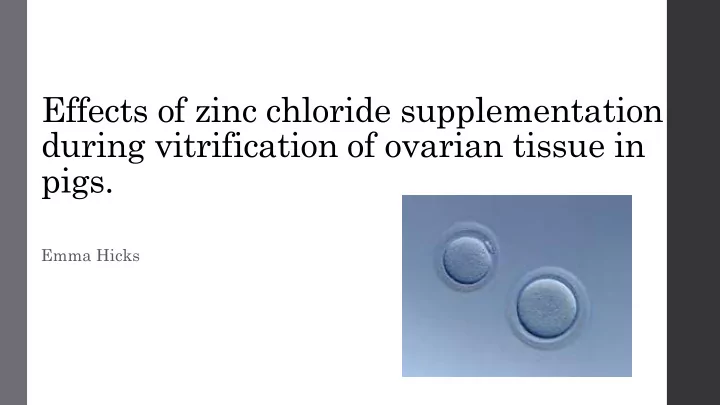

Effects of zinc chloride supplementation during vitrification of ovarian tissue in pigs. Emma Hicks
Cryopreservation • Four Major Steps: Addition of cryoprotectant • Freezing at low temperatures and storing in liquid N 2 • Warming tissue • Thawing cells and removing cryoprotectants • (Adedelahi et al., 2013) ▪ Ovarian tissue cryopreservation preserves large numbers of oocytes versus other techniques. (Adedelahi et al., 2013) • Cryopreservation of ovarian tissue is conducted to help preserve the fertility of biomedical models . (Mouttham & Comizzoli, 2016)
Follicular Damage and Stress • Ovarian tissue is susceptible to more damage during vitrification due to various cell types and water permeability. (Adedelahi et al., 2013) ▪ Vitrification increases reactive oxygen species in oocytes, leading to decreased viability. (Gupta et al., 2010) ▪ Cryoprotectant agents can induce oxidative stress thus causing structural and functional changes in tissue. (Tian et al., 2015) • Zinc reduces oxidative stress by synthesizing proteins that are effective in reducing reactive oxygen species. (Marreiro et al., 2017)
Objectives • Determine the effects of adding 5 μg /mL 𝑎𝑜𝐷𝑚 2 during vitrification on: in vitro follicle development post-thawing fertilization success embryonic development
Experimental Design 5 min 5 min Aspiration of Follicles 0 μg /mL 0 μg /mL 0 μg /mL 5 μg /mL ZnCl 2 ZnCl 2 ZnCl 2 ZnCl 2 7 days Cleavage Blastocyst Ovary Cortex Oocyte Wash Ovary from Cross-Section 5 min 5 min Thawing Media Cycling Gilts 40-44 48 hours hours 144 hours Fertilization Drops Embryo 6-8 Culture hours 5 μg /mL 5 μg /mL ZnCl 2 ZnCl 2 12 hours Centrifuge Wash Semen Pellets Thawing Media Sperm Concentration Dilution Fertilization Characteristics
Follicle Evaluation Primordial Primary Secondary Antral Single layer of Single layer of Theca interna Antrum • • • • squamous cells cuboidal cells Cumulus cells • cells/stratified Granulosa cells • epithelium Zona pellucida •
Damage Characteristics Theca Interna Zona Pellucida No Defined Follicular Cells and Granulosa Disruption Antrum in Cytoplasm Cell Disruption
Follicle Counts Treatment Primordial (%) Primary (%) Secondary (%) Antral (%) 0 μ g/mL ZnCl 2 52.7 a 31.0 a 18.6 a 25.6 a 5 μ g/mL ZnCl 2 39.4 b 34.8 b 14.2 b 29.0 b
Total Follicle Damage Treatment Total Follicles (%) Damaged (%) 0 μ g/mL ZnCl 2 100 46.5 a 5 μ g/mL ZnCl 2 100 23.2 b
Type-Based Follicle Damage 100 90 80 Percent Occurrence (%) 70 60 50 0 μ g/mL Zinc Chloride 40 5 μ g/mL Zinc Chloride 30 20 10 0 a a a a b b b b Primordial Primary Secondary Antral Follicle Types a,b p < 0.05
Fertilization Characteristics Sperm Penetration Rates (%) Media Supplementation % Penetrated 0 μ g/mL ZnCl 2 78.60 ± 12.60 5 μ g/mL ZnCl 2 54.50 ± 14.20 Polyspermy Rates (%) Media Supplementation % Polyspermic 0 μ g/mL ZnCl 2 71.40 ± 12.50 a 5 μ g/mL ZnCl 2 27.30 ± 22.40 b MPN Rates (%) Media Supplementation % MPN Formation 0 μ g/mL ZnCl 2 36.40 ± 13.70 a 5 μ g/mL ZnCl 2 57.10 ± 11.10 b
Embryonic Development 100 90 80 70 60 50 Cleavage 40 Blastocyst 30 20 10 a a a a 0 0 μ g/mL Zinc Chloride 5 μ g/mL Zinc Chloride a,b p < 0.05
Conclusion • Supplementation of 5 mg/mL of ZnCl 2 Improves follicle development: Reduces incidence of follicular damage from vitrification Improves follicular integrity Increases antral follicle development Improves post-thawing fertilization: Reduces incidence of polyspermy Increases male pronucleus formation
Questions?
Recommend
More recommend